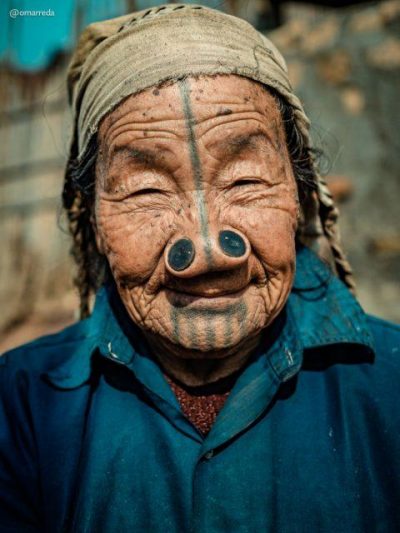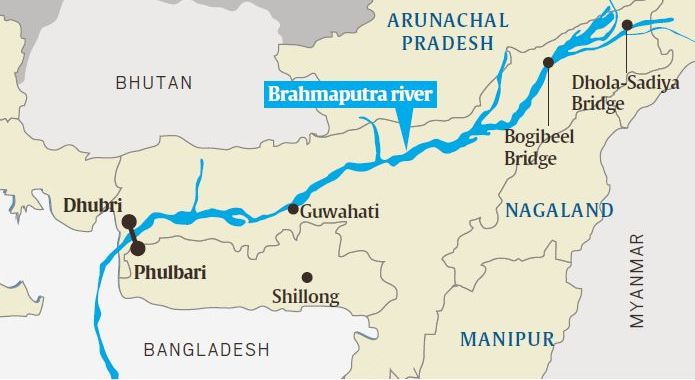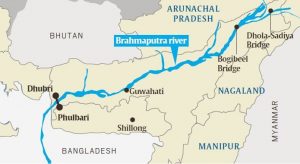09, April 2019 09/04/2019 – Posted in: Daily News – Tags: Apatani Tribe, Candida auris, Country’s longest road bridge, Dhanush, High foreign Capital Inflow, long range artillery guns, Welfare panel for nomadic communities
Apatani Tribe
News Flash
An old village of the Apatani or simply Tanii (village Ziro, Apatani plateau, subansiri district) is found in the mysterious state of Arunachal Pradesh in India.
- The Apatani, recognized by UNESCO as a potential World Heritage Site for their highly efficient agriculture without animals or machines, have been striving to protect their traditional ways in the face of modernization.
- The Apatanis are a very interesting tribe. Unlike the other tribes, they are non-nomadic in nature. They practice permanent wetland cultivation in hilly terrain by slicing the hills, whereas other tribes practice cultivation in dry land by cutting down forests.
- The tribe is known for their colorful culture with various festivals, intricate handloom designs, skills in cane and bamboo crafts, and vibrant traditional village councils called bulyañ. This has made Ziro Valley a good example of a living cultural landscape where man and environment have harmoniously existed together in a state of interdependence even through changing times, such co-existence being nurtured by the traditional customs and spiritual belief systems.
- The Apatanis speak a local language called Tani, and worship the sun and the moon. The tribe has extensive knowledge of herbal remedies to cure most of their ailments. Local ritual specialists also take part in chanting, blood-letting and animal sacrifices in a bid to keep the inhabitants healthy.
- The best time to visit Ziro is during the Murung Rituals in January or during the Dree Festival of July where the tribe practice animal sacrifices to honor the Gods.
Body Modification of women of Apatani
The tribal women’s have tattoos adorning their faces and large nose plugs in their nostrils. Because:
- Women of this tribe are extremely pretty and used to be abducted by men of neighbouring tribes for their beauty.
- In order to stop this from happening, the elders decided to start tattooing the faces of the women and inserting nose plugs from a very young age to make them look less appealing.
- Called Tippei, these tattoos were done when an Apatani girl is about 10-years-old by the elder women. The ink was made up of pig’s fat mixed with soot from the fireplace.
- The Apatani women have a thick straight line tattooed from the forehead to the tip of the nose and five straight lines on the chin. The Apatani men also have a small T shape tattooed on their chins.
- This age-old tradition was observed until the 1970s, when the government imposed a ban on the nose plugs incisions.
Dhanush, long range artillery guns
News Flash
The Ordnance Factory Board (OFB) handed over the first batch of Dhanush artillery guns to the Army. Dhanush is the indigenously upgraded gun of the Swedish Bofors gun procured in the 1980s.
Dhanush is a 155 mm, 45-calibre towed artillery gun with a range of 36 km and has demonstrated a range of 38 km with specialised ammunition. It is an upgrade of the existing 155m, 39 calibre Bofors FH 77 gun. It is compatible with all North Atlantic Treaty Organisation (NATO) 155 mm ammunition system.
Gun Carriage Factory (GCF) got the Dhanush project in October 2011 and the first prototype was made in 2014.
Features
- The gun is fitted with inertial navigation system with global positioning system- (GPS) based gun recording and auto-laying.
- It has enhanced tactical computer for onboard ballistic computations.
- It consists of onboard muzzle velocity recording.
- The automated gun sighting system is equipped with camera, thermal imaging and laser range finder.
Technical features
The 155/45 Cal Gun System with electronic suite comprises the following unique features:
- 155/45 Cal barrel.
- Modified double baffle muzzle brake.
- Modified loading trough to accommodate BMCS Zone-6.
- Electronic suite for enhanced firing accuracy and auto laying.
|
FEATURE |
155mm FH77 BOFORS |
DHANUSH |
|
Gun Recording |
Collimator & Director | Based on Inertial Navigation system |
|
Gun Laying |
|
|
|
Gun Computer |
Not available |
Enhanced Tactical computer |
| Communication system | Radio Based |
Compatible with SHAKTI and STAR V |
|
Visibility |
Day/Night/ Panoramic |
CCD Cameras/ IRF/TI |
Gun Control Computer (GCU/ETC)
- Inertial Navigation System (INS).
- INU, CDU, Phonic Wheel, Travel Lock sensor.
- Muzzle Velocity Radar (MVR).
- Gun Sighting System.
- Modified Electro-hydraulic Valve Block system.
- Communication System-STARS V Radio MK II.
Significance
- Artillery (heavy guns) played a big part in the battlefields. A bombardment that was aimed well could destroy enemy trenches, and knock out artillery batteries (groups of guns) and communication lines. It could also help break up an attack by infantry (soldiers on foot).
- The artillery forces call for maximal range and rate of fire.
Disadvantages
- Rate of fire is quite low as they are longer-ranged guns and they had a higher calibre and thus heavier payloads.
- Ammunition refilling is time consuming.
Source: The Hindu
Welfare panel for nomadic communities
News Flash
For the development and identifying de-notified, nomadic and semi-nomadic communities, a committee will be set up under NITI Aayog.
A Welfare Development Board will also be set up under the Ministry of Social Justice and Empowerment to design and implement programmes for these hard-to-reach communities.
Background
- Activists from these communities that include tribes like Chharas, Nats, Madaris, Dafers etc. have been engaged in working among 125 communities spread over 14 states.
- One of the key concerns aired by these communities is reservation benefits as a compartmentalized sub group.
Why Community is Unhappy
- The committee under the chairpersonship of Vice-Chairman of NITI Aayog that will complete the process of identification of the communities that have not yet been formally classified.
- The government had constituted a committee in 2014 that was supposed to identify these communities and prepare a state wise list within three years.
- The government wants to list those DNTs, NTs and SNTs who are not falling under the category of Scheduled Castes (SC), Scheduled Tribes (ST) or Other Backward Tribes (OBC).
- But since majority of these tribes are already in these categories and are the most disadvantaged, are seeking benefits under a separate schedule or compartmentalized category.
- While there are 200 such communities listed since 1952, the present government claims there are 400 plus tribes.
- The originally identified tribes which are already listed as SC, ST or OBC like Chharas, Dafer and Pardis also denying benefits from governemnt.
Community’s demands
- These communities want that special component be included for them in all the government schemes aimed at housing, rehabilitation, education and scholarships.
- The National Urban Livelihood Mission and National Rural Livelihood Mission should have a special component and budget for these tribes reserved in these programmes.
- These communities have also been looking towards land ownership as they feel that land is the most precious resource that can guarantee their upliftment.
- Another important demand has been about a review of certain laws like Beggary Prevention Act, Forest Rights Act and Wildlife Protection Act in context of these communities.
- The DNT, NT and SNT communities have been demanding open spaces for performing their traditional and folk arts along with budgetary allocation for training and development of their cultural heritage.
- They have also been seeking a campaign for providing essential documents like ration cards, Aadhar Card, caste certificates and bank accounts to these communities.
- DNT Adhikar Manch have been demanding that one fifth of the National Skill Development Fund be utilized for developing traditional and non traditional skills among Muslims, DNTs and NTs.
Source: The citizen
Country’s longest road bridge
News Flash
The country’s longest road bridge now runs 9.15 km over the river from Dhola to Sadiya in Assam’s Tinsukia district.
The government has also announced the longest bridge of the country (19.28Km) will also come up in Assam. (expansion from Dhubri in Assam to Phulbari in Meghalaya.)
4.94-km Bogibeel Bridge over the Brahmaputra, India’s longest rail-road bridge, connects Assam’s Dibrugarh and Dhemaji districts.
Source: Indian Express
High foreign Capital Inflow
News Flash
The inflow of foreign capital into India’s stock market in the month of March hit a high of $4.89 billion, the biggest foreign inflow into Indian stocks since February 2012.
Last year, India received more foreign direct investment than China for the first time in two decades. India has emerged as the fastest-growing major economy. Investors expect India to be a major source of global growth in the coming years.
Reasons
- Both cyclical and structural factors are behind this sudden uptick in foreign investment that has helped the rupee make an impressive comeback.
- There is a sense among a section of investors that their fears of political instability are misplaced.
- Both the Federal Reserve and the European Central Bank have promised to keep interest rates low for longer. This has caused investors to turn towards relatively high-yielding emerging market debt.
Currency Appreciation : The rupee has appreciated by about 7% since early October, when it was reeling at around 74 against the dollar. Indian mid-cap stocks, which suffered a deep rout last year, are now too attractive to ignore for many foreign investors.
What will be the coming challenges
- Competition from other emerging Asian economies.
- New government in New Delhi has to increase the pace of structural reforms and also ensure proper macroeconomic management with the help of the Reserve Bank of India.
- Long-pending reforms to the labour and land markets are the most pressing structural changes that will affect India’s long-term growth trajectory.
- The high fiscal deficit of both the Centre and the State governments and the disruptive outflow of foreign capital are the other macroeconomic challenges.
Source: Indian Express
National Institution Ranking Framework
News Flash
The Indian Institute of Technology, Madras (IIT-Madras) has topped the Centre’s ranking of higher education institutions, followed by the Indian Institute of Science, Bengaluru, and IIT-Delhi. Seven IITs appear in the top 10 list of the National Institution Ranking Framework (NIRF) for 2019, while Jawaharlal Nehru University, Delhi and Banares Hindu University, Varanasi, take the remaining places.
Background
National Institution Ranking Framework rankings are being published annually since 2016. These are based on multiple parameters, including teaching, learning and resources; research and professional practice; graduation outcomes; outreach and inclusivity; and the perception of the public, academics and employers. Overall, 3,127 institutions applied for different categories of the NIRF this year.
Ranking as per different categories
- Overall category: IIT Madras tops the list of best institutes in the Overall category.
- Law category: National Law School of India University, Bengaluru and National University, New Delhi are ranked top.
- Architecture category: IIT Kharagpur and IIT Roorkee have secured the first two positions respectively.
- Indian medical institutes: AIIMS New Delhi and PGIMER Chandigarh have secured first two ranks.
- Colleges category: Miranda House and Hindu College are ranked first and second.
- Pharmacy category: Jamia Hamdard has secured the first rank in Indian institute followed by Panjab University.
- Indian Management institutes: IIM Bangalore and IIM Ahmedabad are placed as first and second.
- Indian Engineering institutes: IIT Madras and IIT Delhi are placed at the top.
- Universities category: IISc Bangalore has topped the category followed by JNU, New Delhi.
NIRF
The National Institutional Ranking Framework (NIRF) was approved by the MHRD and launched by Honourable Minister of Human Resource Development on 29th September 2015.
This framework outlines a methodology to rank institutions across the country. The methodology draws from the overall recommendations broad understanding arrived at by a Core Committee set up by MHRD, to identify the broad parameters for ranking various universities and institutions. The parameters broadly cover “Teaching, Learning and Resources,” “Research and Professional Practices,” “Graduation Outcomes,” “Outreach and Inclusivity,” and “Perception”.
Significance
- Ranking promotes competition among the Universities and drive them to strive for excellence.
- Government has also started a scheme called ‘Institutions of Eminence’ in which 20 institutions both public and private, would be selected on challenge method and they would be actively supported to come up in the global ranking.
- It also promote Research and Development in Higher Education.
Importance of ranking
- During admissions, students looking to study in reputed institutions for their bright future and thus in selecting a better choice can be filled by this ranking system.
- Prior to this initiative, Indian students have had to rely on the Shanghai or the QS World Rankings which do not take into account the peculiarities of our subcontinent.
Criticism
- No cross-verification of data before announcing the ranking.
- The data used for evaluation was submitted by the institutions themselves.
- The IITs have chosen to participate in the rankings under the “engineering” category.
- IITs should have competed under the category of “universities”.
- Some specific disciplines institutions like Institute of Chemical Technology is ranked along with multidisciplinary universities like JNU/BHU.
Source: India Today
ICMR’s ethical research guidelines mandatory
News Flash
The Indian Council of Medical Research’s (ICMR) National Ethical Guidelines for Biomedical Research is now mandatory and needs to be adhered to for all biomedical research in India, as per the New Drugs and Clinical Trials Rules 2019.
Background
The Indian Council of Medical Research (ICMR) had released a handbook on national ethical guidelines, which is aimed at improving the overall quality of research outcomes while ensuring protection of research participants and responsiveness to the health needs of Indians.
The ICMR has been preparing ethical guidance documents for the conduct and review of biomedical and health research in India since 1980. It was revised in 2000, 2006 and 2017.
The latest document ‘National Ethical Guidelines for Biomedical and Health Research Involving Human Participants’ was released in October 2017.
Source: Express Healthcare
India- Maldives Relations
After achieving majority in parliament President Ibrahim Solih’s party can give much time and effort to strengthen relations with India.
- So far as India’s interests in the Indian Ocean Region are concerned, warm bilateral ties between New Delhi and Male are a high priority after five years of strategic drift that benefited Beijing considerably.
- As it seeks to unravel this web of Chinese loans, the new leadership has promised that what is owed would be paid. As Mr. Solih grapples with these challenges, the assurance that the Maldives has New Delhi’s backing would be vital.
- After new government came in Male the change could be seen in the very high-level visits. Prime Minister Narendra Modi attended President Solih’s swearing-in ceremony. President Solih visited Delhi a month after being sworn in. A $1.4 billion financial assistance package for the Maldives was announced, and the two governments agreed to exempt holders of diplomatic and official passports from visa requirements. The recent visit by External Affairs Minister Sushma Swaraj cemented many aspects of the cooperation agenda we have been drawing up.
- MoUs on Indian grant aid for “high-impact community development projects” have been signed, as also agreements on clean energy and regional maritime security.
- The generous development assistance provided by the Indian government is going into people-oriented projects like providing fresh water, sanitation, sewerage. Building roads and moving the Male commercial harbour to Thilafushi [island west of Male] are huge projects that are going to be major symbols of cooperation between the two countries.
ATTENTION
Candida auris
The germ, a fungus called Candida auris , preys on people with weakened immune systems, and it is quietly spreading across the globe. Over the past five years, it has hit a neonatal unit in Venezuela, swept through a hospital in Spain, forced a prestigious British medical centre to shut down its intensive care unit, and taken root in India, Pakistan and South Africa.
What is the threat
Candida auris is so tenacious, in part, because it is immune to major antifungal medications, making it a new example of one of the world’s most intractable health threats: the rise of drug-resistant infections.




